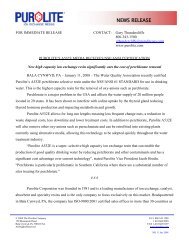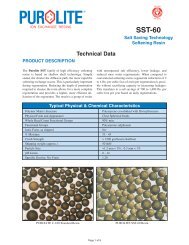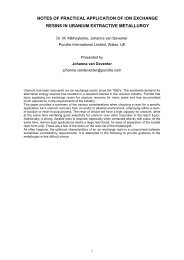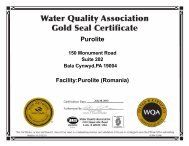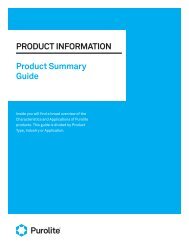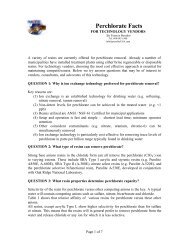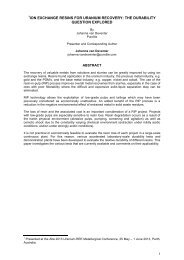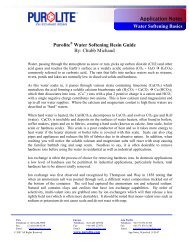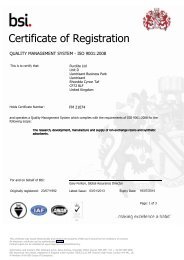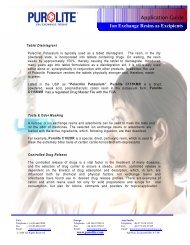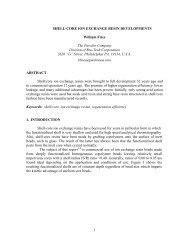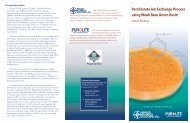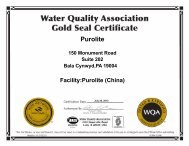Cane Sugar Refining - Purolite
Cane Sugar Refining - Purolite
Cane Sugar Refining - Purolite
You also want an ePaper? Increase the reach of your titles
YUMPU automatically turns print PDFs into web optimized ePapers that Google loves.
<strong>Cane</strong> <strong>Sugar</strong> <strong>Refining</strong> with Ion Exchange Resins<br />
Color Removal Mechanism<br />
Two main mechanisms are involved in sugar colorant fixation to strong base anion<br />
exchange resins: ionic bonding between anionic colorants and the resin’s fixed charges,<br />
and hydrophobic interaction between non-polar parts of the colorant and the styrene<br />
divinylbenzene resin matrix.<br />
Since most sugar colorants have an anionic nature, being charged negatively, strong<br />
base anionic resins are efficient decolorizers. However, both mechanisms can affect the<br />
same colorant molecule in amplified ionic binding. Carboxylic acids and phenols of low<br />
molecular weight are fixed by chemical reaction and by molecular interaction to the<br />
resins. Large, high molecular weight organic acids can be bound chemically and by<br />
interaction at several different resin sites, reinforcing the binding, and making their<br />
removal from the resin difficult.<br />
Also, colorants fixed to resin can switch from one mechanism to the other during<br />
regeneration. This may explain the high efficiency of styrenic resins as sugar decolorizers<br />
when new, the difficulty of removing colorants from them during regeneration, and the<br />
rapid decrease of their efficiency in use.<br />
It has been claimed that about 10% of the resin ion exchange capacity is actively<br />
involved in decolorization, most probably on the surface of the resin beads. It has also<br />
been suggested that most of the decolorization of strong base polystyrenic resins (except<br />
at high pH) occurs in the resin structure and not at the functional groups. This is due<br />
to the relatively high electronic density in the aromatic structure, which is attractive<br />
for non-polar and electrophilic species. At high pH values, ion exchange mechanisms<br />
will predominate.<br />
9<br />
Adsorption of sugar colorants to ion exchange resins are governed by:<br />
• Colorant molecular weight<br />
• Charge density<br />
• Type of charge (highly anionic, weakly anionic, amphoteric or weakly cationic)<br />
• Degree of hydrophobicity<br />
• pH<br />
• Ionic strength of the medium.<br />
Several mechanisms have to be considered:<br />
Steric effect: The colorants vary in molecular weight; thereby the porosity of<br />
the decolorizing media is a key parameter. The molecular weight of sugar<br />
colorants varies from 30 kDa to 1000 kDa for cane sugar. In order to achieve<br />
good decolorization kinetics the ratio of micropores, meso pores and macropores<br />
is an important parameter. This illustrates why the decolorization of sugar juices<br />
is carried on at relatively low flow rate.<br />
Hydrophobic effect: Activated carbon has a virtually non-polar surface whereas<br />
polymeric adsorbents have a polarity (acrylic matrix decolorizers are more hydrophilic<br />
than the styrenic ones). The colorants are basically hydrophobic (not highly soluble in<br />
water) and will tend to be adsorbed on the hydrophobic part of the adsorption media.<br />
This is most probably the main mechanism in color removal. Pure polymeric adsorbents<br />
have demonstrated their effectiveness in removing colored species (high hydrophobicity,<br />
high surface area). Being not functionalized (or slightly) they can operate in a salty



